




Your support is critical to our success.
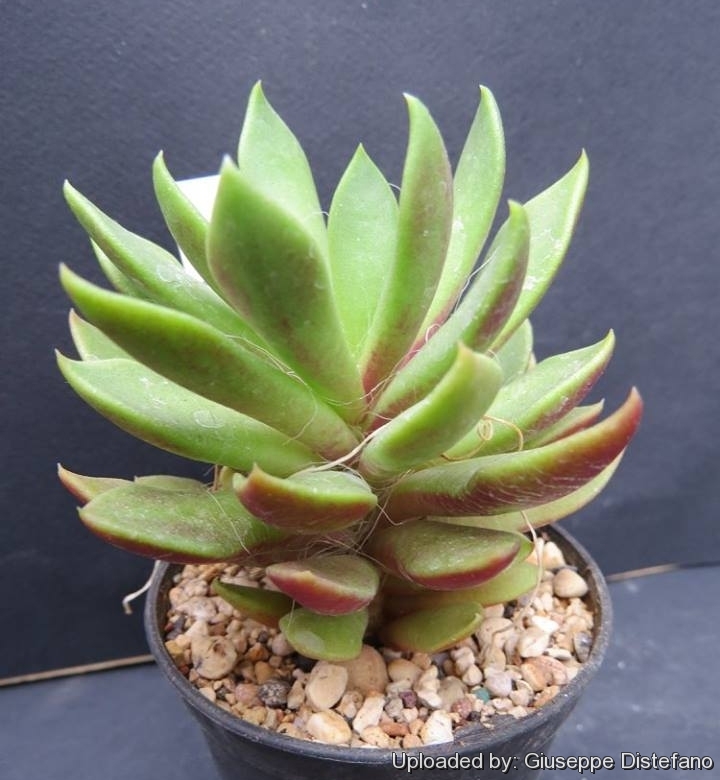
Origin and Habitat: South Africa Cape Province.
Synonyms:
- Anacampseros rufescens Sweet
Anacampseros rufescens Sweet
Hort. Brit. [Sweet] 170. 1826
Synonymy: 2 Cultivars (1):
RUSSIAN (Русский): Анакампсерос краснеющий
Description: Anacampseros rufescensSN|1314]]SN|25397]] is a freely branching leaf succulent that forms low clumps or mats up to a height of only a few centimetres. Leaves are purplish underneath as well as the peduncles and flowers. Attractive, white filament-like hairs are present along the stems adding a nice contrast to the dark foliage. This is the largest of all the Anacampseros species.
Stems: Dichotomously branched, 5-8(-10) cm long, erect or creeping.
Roots: Thick and tuberous
Leaves: Up to 70 per rosette, crowded and spirally arranged, obovate-lanceolate, acute or somewhat acuminated, expanded, somewhat recurred at the apex, unequal in size the larger to 2 cm tall and 1 cm broad woolly in the axil, hairless when mature. The upper surface is dark olive green but, as many succulents do, takes on a reddish cast in the sun or under stress conditions, the underside is usually dark purple. Stipule-hairs white, numerous, bristle-like often wavy.
Flowers: Like those of Anacampseros telephiastrumSN|25397]]SN|1314]], single or up to 3-4 together, 2-3 cm in diameter, pink or purple-red, mildly fragrant, quite showy and resemble flattened Portulaca flowers. The flowering stems are 7-10 cm long end get often leggy as the buds form. Stamens numerous numerous pink with golden yellow anthers. Ovary greenish, style pink and stigma lobes white.
Phenology: Flowers open in late spring for a short period in the afternoon only and close every night.
Seeds: Adapted to wind dispersal, the outer layer of the outer integument is papery and can be separated from the inner layer of the outer integument, forming a balloon.
Cotyledons: 2, thick, somewhat trigonal, convex beneath, with a very short caulicule.
Bibliography: Major references and further lectures
1) George Don, Philip Miller “A General System of Gardening and Botany: Founded Upon Miller's Gardener's Dictionary, and Arranged According to the Natural System” Volume 3 C. J. G. and F. Rivington, 1834
2) Alwin Berger “Mesembrianthemen und Portulacaceen. Beschreibung und Anleitung zum Bestimmen der wichtigsten Arten, mit kurzen Angaben über die Kultur” Stuttgart, Ulmer 1908
3) Edgar Lamb, Brian Lamb “The illustrated reference on cacti & other succulents”, Volume 1 Blandford Press, 1955
4) Hermann Jacobsen “A Handbook of Succulent Plants” Blandford Press (April 1960)
5) Walther Haage “Cacti and succulents: a practical handbook” Dutton, 1963
6) Michael Wright “The Complete indoor gardener” Random House, Incorporated, 1975
7) Stan Dworkin, Floss Dworkin “The apartment gardener” New American Library, 01/Apr/1974
8) B. M. Johri, Kunda B. Ambegaokar, Prem S. Srivastava “Comparative embryology of angiosperms” Volume 1 Springer-Verlag, 1992

Anacampseros rufescens Photo by: Giuseppe Distefano

Anacampseros rufescens Photo by: Valentino Vallicelli
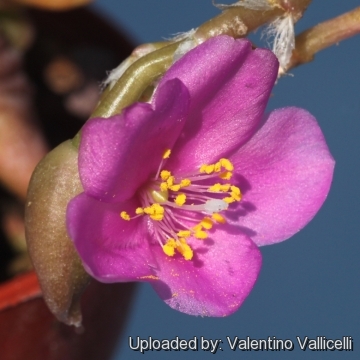
Anacampseros rufescens Photo by: Valentino Vallicelli
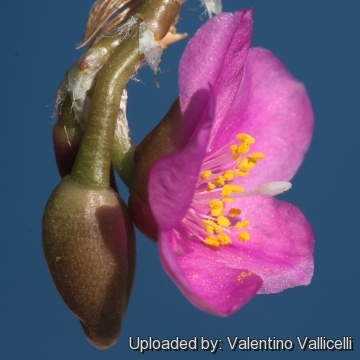
Anacampseros rufescens Photo by: Valentino Vallicelli
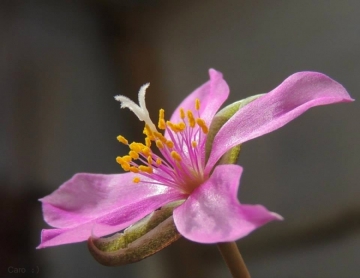
Anacampseros rufescens Photo by: Carolina González
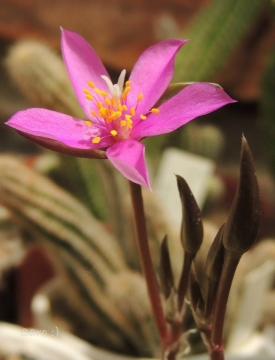
Anacampseros rufescens Photo by: Carolina González
Cultivation and Propagation: Anacampseros rufescensSN|25397]]SN|25397]] is one of the more common species in cultivation and quite resistant to cultivation. The only things that can kill this plant are cold and overwatering. Nevertheless, it is appropriate to provide adequate growing conditions in order to obtain compact plant with many flowers.
Growth rate: Slow growing to start but does well under cultivation. They need to be moderately large (about 20 cm in diameter) before they flower.
Soils: Use a an open and free draining mineral compost with little organic matter (peat, humus) that allows therefore roots to breath (as it is rot prone). Outdoors a well-draining rocky or sandy soil is ideal.
Repotting: Repot Anacampseros rufescensSN|25397]]SN|25397]] once a year in order to evaluate the health of the plant and provide a larger growing space being careful not to damage the sensitive roots.
Watering: It likes a winter's rest and should be kept completely dry during the winter months. From early spring onwards the plant will begin to grow and watering should be increased gradually until late spring when the plant should be in full growth. Water regularly during the aestival growth cycle so long as the plant pot is allowed to drain and not sit in a tray of water (this plant need plenty of water) But needs to be avoided wetting the bodies of these plants while they are in sunlight. A wet plant in the sun light can cause sun burning which can lead to scares or even fungal infections and death. From late summer watering should be reduced to force the plant to go in to a state of semi dormancy, by autumn you should be back in to the winter watering regime. Keep dry with ample airflow in winter (but for outdoors cultivation it is somewhat resistant to wet conditions, too if grown in very draining substrata). In the rest period no high atmospheric humidity!! Care must be taken with watering as they tends to become swollen and untidy in growth habit if given too much water and shade.
Fertilization: Feed with a high potassium fertilizer in summer during the growing season diluted to one-fourth potency and mix into the watering can for application.
Hardiness: Keep dry at 5- 10° C in winter, but can tolerate sporadic light frost if kept on the dry side prior to, and during, cold weather. Pots may be placed outdoors during the summer months, but must be moved indoors during the winter. USDA zones 9-11
Exposition: The plant tolerates bright situations, if kept too dark they may become overly lush and greener and could be prone to rotting due to over watering. Strong but filtered light encourages flowering, but is likely to suffer from sun scorch or stunted growth if over exposed to direct sunlight during the hottest part of the day in summer. .
Uses: It is an excellent plant for container growing. It always looks good and stays small. It look fine in a cold greenhouse and frame. It do well outdoors in raised beds, rock gardens and terraces as well. The slowly creeping stems cluster freely to form mats as a small area ground cover. Anacampseros rufescensSN|25397]]SN|25397]] also makes an excellent potted windowsill plant.
Pests & diseases: It may be attractive to a variety of insects, but plants in good condition should be nearly pest-free, particularly if they are grown in a mineral potting-mix, with good exposure and ventilation. Nonetheless, watch carefully for any significant decline in health. This may signal a pest problem that should be dealt with quickly in order to prevent scarring, stunting and even death.
- Red spiders: Red spiders may be effectively rubbed up by watering or misting the plants from above.
- Mealy bugs: Mealy bugs occasionally develop aerial into the new growth among the leaves with disfiguring results, but the worst types develop underground on the roots and are invisible except by their effects. Eliminate mealybug infestations by dabbing the critters with cotton swabs dipped in alcohol or by soaking the succulent roots in a systemic insecticide.
- Scales: Scales are rarely a problem.
- Rot: This species is particularly easy and accommodating, seldom suffer of cryptogamic diseases. Rot it is only a minor problem with cacti if the plants are watered and “aired” correctly. If they are not, fungicides won't help all that much.
Propagation: it is easy to propagate either through stem cuttings or seed. Seed germinate in 14-21 days at 21°C. Sow in a well drained medium.
| Your Actions | |
|---|---|
| Back to Anacampseros index | |
| Back to Portulacaceae index | |
 |
Back to Succulents Encyclopedia index |
Privacy stantement - Terms and conditions - How to cite - About us - Feedback - Donate



